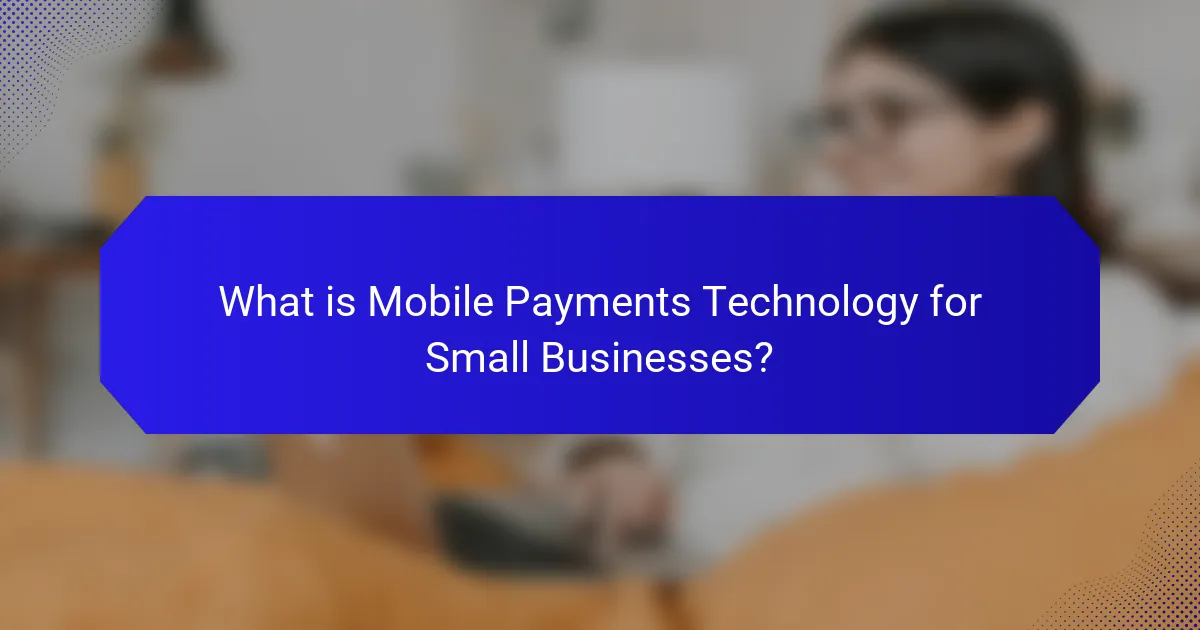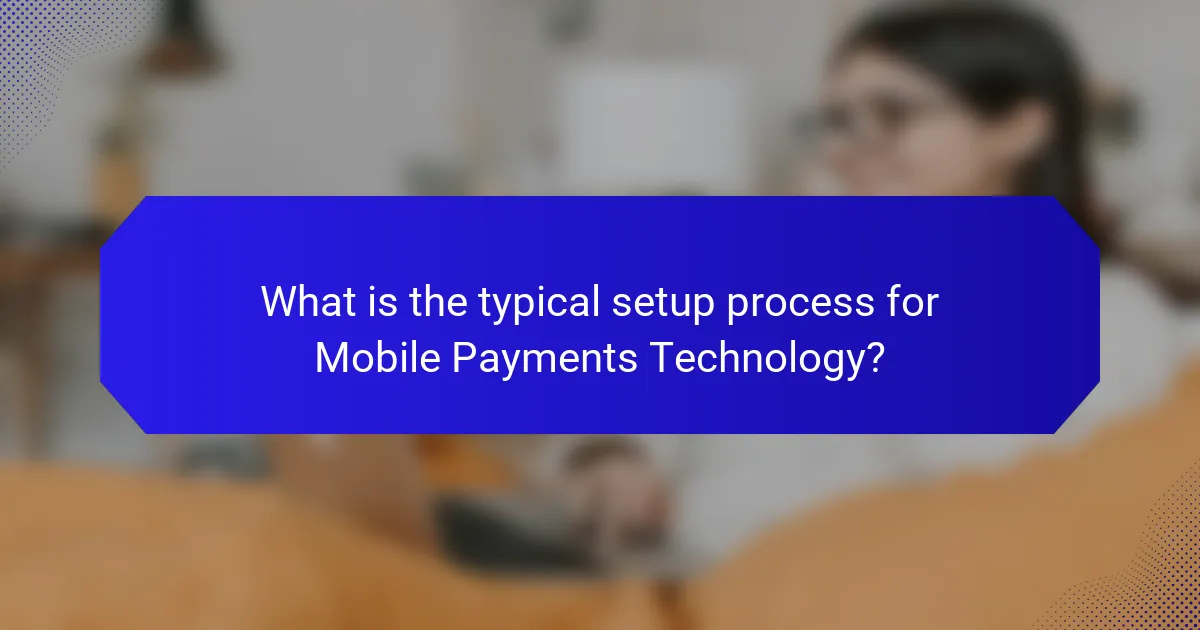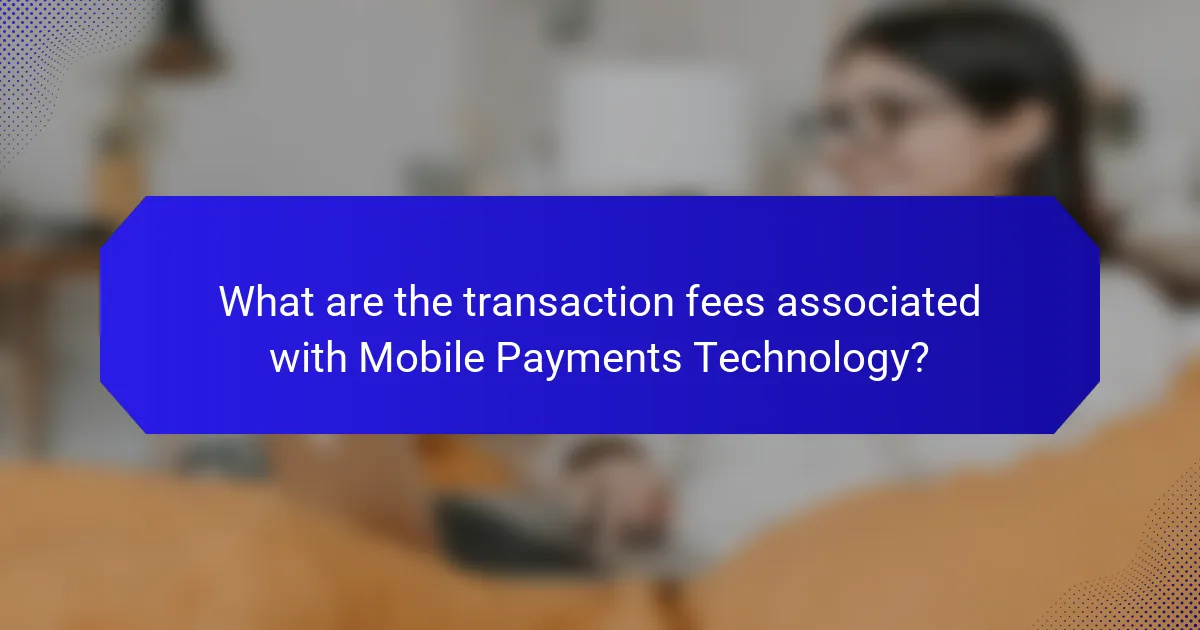Mobile payments technology encompasses digital payment solutions that enable customers to conduct transactions through mobile devices, including mobile wallets, contactless systems, and app-based platforms. This technology offers small businesses advantages such as quicker transactions and enhanced customer convenience, with a projected global transaction value exceeding $12 trillion by 2025. The setup process involves selecting a mobile payment provider, creating an account, downloading the necessary app, and configuring hardware like card readers. Transaction fees typically range from 1.5% to 3.5%, varying by provider and service, making it essential for small businesses to understand these costs for better financial planning.

What is Mobile Payments Technology for Small Businesses?
Mobile payments technology for small businesses refers to digital payment solutions that allow customers to make transactions using mobile devices. This technology typically includes mobile wallets, contactless payment systems, and app-based payment platforms. Small businesses can benefit from faster transactions and improved customer convenience. According to a report by Statista, mobile payment transaction value worldwide is expected to reach over $12 trillion by 2025. This growth indicates a significant shift towards mobile payment adoption among consumers.
How does Mobile Payments Technology function?
Mobile payments technology functions by enabling transactions through mobile devices. Users can make payments using apps or digital wallets. This technology utilizes Near Field Communication (NFC) or QR codes for secure transactions. NFC allows devices to communicate wirelessly when in close proximity. QR codes enable users to scan a code to complete a payment. Transactions are processed through a secure gateway that encrypts data. This ensures sensitive information is protected during the transaction. Mobile payments are increasingly popular, with a reported global market value of $1.5 trillion in 2020. The convenience and speed of mobile payments drive their adoption among consumers and businesses alike.
What are the key components of Mobile Payments Technology?
The key components of mobile payments technology include a mobile device, payment application, payment gateway, and security protocols. A mobile device serves as the hardware for transactions. Payment applications facilitate the processing of payments. Payment gateways connect the application to financial institutions for transaction authorization. Security protocols ensure data protection during transactions. These components work together to enable seamless and secure mobile payment experiences for users.
How do these components interact in a payment transaction?
In a payment transaction, components such as the payment gateway, processor, and bank interact to facilitate the exchange of funds. The payment gateway captures payment information and encrypts it for security. This information is then sent to the payment processor, which verifies the transaction with the issuing bank. The bank checks the buyer’s account for sufficient funds and either approves or declines the transaction. If approved, the funds are transferred from the buyer’s account to the seller’s account. This interaction occurs in real-time, typically within seconds. According to a study by the Federal Reserve, electronic payment transactions accounted for 68% of all payment volume in the U.S. in 2020, highlighting the efficiency of these components.
What are the advantages of using Mobile Payments Technology?
Mobile payments technology offers several advantages for users and businesses. It enhances convenience by allowing quick transactions through smartphones or tablets. Users can make payments anytime and anywhere, streamlining the purchasing process.
Security is another key advantage. Mobile payments often utilize encryption and tokenization, making transactions safer than traditional methods. According to a report by Juniper Research, mobile payment fraud is significantly lower than credit card fraud.
Cost efficiency is also notable. Businesses can reduce overhead costs associated with cash handling and processing. Many mobile payment platforms charge lower transaction fees compared to traditional credit card processors.
Furthermore, mobile payments facilitate better customer engagement. They enable businesses to offer loyalty programs and promotions directly through the payment app. This can lead to increased customer retention and sales.
Overall, mobile payments technology provides convenience, security, cost savings, and enhanced customer interaction.
How does Mobile Payments Technology enhance customer experience?
Mobile payments technology enhances customer experience by providing convenience and speed in transactions. Customers can make purchases quickly using their smartphones, reducing wait times at checkout. This technology allows for contactless payments, which are hygienic and safe. Additionally, mobile payments often integrate loyalty programs, giving customers rewards for their purchases seamlessly. According to a study by Statista, 45% of consumers prefer mobile payments for their speed and ease of use. Enhanced security features in mobile payments also build customer trust. Overall, mobile payments streamline the buying process, making it more efficient and enjoyable for customers.
What cost efficiencies can small businesses achieve?
Small businesses can achieve cost efficiencies through mobile payments technology. This technology reduces transaction fees compared to traditional payment methods. It also minimizes the need for physical infrastructure, lowering overhead costs. Mobile payments streamline the checkout process, enhancing customer experience and potentially increasing sales. Moreover, they enable better tracking of sales data, which aids in inventory management and reduces waste. According to a study by the Federal Reserve, businesses using mobile payment systems reported a 20% reduction in processing costs. This demonstrates that adopting mobile payment solutions can lead to significant financial savings for small enterprises.
What challenges do small businesses face with Mobile Payments Technology?
Small businesses face several challenges with mobile payments technology. These include high transaction fees that can impact profit margins. Many mobile payment providers charge fees ranging from 1.5% to 3% per transaction. Additionally, the setup process can be complex and time-consuming. Small businesses may struggle to integrate mobile payment systems with existing infrastructure. Security concerns also pose a significant challenge. Data breaches and fraud can undermine customer trust. Furthermore, not all customers are familiar with mobile payment options. This can lead to lower adoption rates among certain demographics. Finally, technical issues such as connectivity problems can disrupt transactions. These challenges collectively hinder the effective use of mobile payments by small businesses.
What are the common security concerns associated with mobile payments?
Common security concerns associated with mobile payments include data breaches, unauthorized transactions, and malware. Data breaches can expose sensitive information, such as credit card details and personal data. Unauthorized transactions occur when a user’s account is accessed without consent. Malware can infect mobile devices, leading to theft of payment information. According to a 2021 report by the Federal Trade Commission, mobile payment fraud has increased by 20% in recent years. Additionally, the use of public Wi-Fi networks can heighten security risks, as they may not be secure.
How can small businesses overcome technical barriers?
Small businesses can overcome technical barriers by investing in user-friendly technology solutions. This includes selecting mobile payment systems that are designed for ease of use. Training employees on these systems can enhance operational efficiency. Additionally, seeking technical support from service providers can resolve issues quickly. Collaborating with local tech experts can also provide tailored solutions. Utilizing cloud-based platforms can streamline operations and reduce maintenance costs. According to a report by the U.S. Small Business Administration, 70% of small businesses that adopt new technologies see improved customer satisfaction.

What is the typical setup process for Mobile Payments Technology?
The typical setup process for mobile payments technology involves several key steps. First, a business must choose a mobile payment provider. Popular providers include Square, PayPal, and Stripe. Next, the business needs to create an account with the chosen provider. This usually involves providing business information and banking details.
After account creation, the business must download the relevant mobile payment app. The app is essential for processing transactions. Then, the business needs to set up hardware, such as card readers or NFC devices, if necessary. These devices allow customers to make payments using cards or mobile wallets.
Finally, the business should test the system to ensure it functions correctly. This includes processing a test transaction. According to a report by the Federal Reserve, mobile payments are growing rapidly, highlighting the importance of an efficient setup process for businesses.
What steps are involved in setting up mobile payment systems?
Identify a mobile payment provider. Research options such as Square, PayPal, or Stripe. Choose a provider that fits your business needs. Create an account with the selected provider. This usually requires basic business information and banking details. Obtain necessary hardware, like a card reader or mobile device. Configure the payment system according to the provider’s guidelines. Test the system to ensure it works correctly. Train staff on how to use the mobile payment system effectively.
What equipment and software are necessary for setup?
To set up mobile payments technology for small businesses, essential equipment includes a smartphone or tablet and a card reader. The card reader can be a standalone device or integrated with the smartphone. Software requirements involve a mobile payment application compatible with the card reader. Popular applications include Square, PayPal Here, and Clover. These applications facilitate transaction processing and inventory management. Additionally, a reliable internet connection is necessary for real-time payment processing. Research shows that businesses utilizing mobile payment solutions can increase transaction speed and customer satisfaction.
How long does the setup process usually take?
The setup process for mobile payments technology usually takes between one to three days. This timeframe includes account creation, software installation, and configuration. Some providers may offer expedited services that shorten this duration. Additionally, businesses may need time for staff training on the new system. Overall, the setup time can vary based on the complexity of the technology and the specific requirements of the business.
What factors should small businesses consider during setup?
Small businesses should consider several factors during setup. First, they must evaluate their target market and customer preferences. Understanding customer demographics influences payment technology choices. Next, businesses should assess the cost of mobile payment systems. This includes hardware, software, and transaction fees. Compliance with legal and regulatory requirements is crucial. Businesses must ensure they meet industry standards for data security. Additionally, the ease of integration with existing systems is important. A seamless setup enhances operational efficiency. Finally, ongoing customer support options should be considered. Reliable support can significantly impact business operations.
How do business size and industry affect setup choices?
Business size and industry significantly influence setup choices for mobile payment technology. Larger businesses often require more complex systems to handle higher transaction volumes. They may invest in advanced hardware and software solutions for efficiency. In contrast, small businesses typically opt for simpler, cost-effective solutions. Industry type also plays a crucial role. Retail businesses may prioritize point-of-sale systems, while service industries might focus on mobile payment apps. Specific industries have unique compliance requirements that affect setup choices. For example, the food industry must adhere to health regulations, influencing payment system features. Thus, both size and industry shape the selection of mobile payment solutions.
What payment processors are most suitable for small businesses?
Square, PayPal, and Stripe are the most suitable payment processors for small businesses. Square offers a free point-of-sale system and charges a flat rate of 2.6% plus 10 cents per transaction. PayPal provides easy integration and allows businesses to accept payments via email or website with fees starting at 2.9% plus 30 cents per transaction. Stripe is known for its developer-friendly API and charges 2.9% plus 30 cents per transaction as well. These processors are popular due to their low startup costs and user-friendly interfaces. They also offer robust customer support and detailed reporting features.

What are the transaction fees associated with Mobile Payments Technology?
Transaction fees for mobile payments technology typically range from 1.5% to 3.5% per transaction. These fees vary based on the payment processor and the specific service used. For example, services like PayPal and Square charge around 2.6% plus a fixed fee per transaction. Other providers may offer different rates depending on transaction volume and business type. Additionally, some mobile payment platforms may charge monthly fees or setup fees. Understanding these costs is crucial for small businesses to assess overall expenses.
How are transaction fees structured in mobile payments?
Transaction fees in mobile payments are typically structured as a percentage of the transaction amount plus a fixed fee. The percentage usually ranges from 1.5% to 3.5% per transaction, depending on the payment processor. The fixed fee can vary, often between $0.10 and $0.30. Some processors may have tiered pricing models that offer lower rates for higher transaction volumes. Additionally, there may be monthly fees or setup fees associated with using a mobile payment service. These fees are influenced by factors such as the type of business, transaction volume, and the specific payment processor chosen. Understanding these structures is essential for small businesses to manage costs effectively.
What are the typical fee ranges for different payment processors?
Typical fee ranges for different payment processors vary significantly. Most processors charge between 1.5% to 3.5% per transaction. For example, PayPal generally charges around 2.9% plus a fixed fee based on the currency. Square typically has a fee of 2.6% plus 10 cents per transaction. Stripe’s fees are similar, at 2.9% plus 30 cents per transaction. Some processors may offer lower rates for high-volume businesses. Additionally, there may be monthly fees or setup costs depending on the processor. These fees can impact the overall cost efficiency for small businesses utilizing mobile payment technology.
How do transaction fees impact overall business profitability?
Transaction fees directly reduce overall business profitability. These fees are costs incurred during payment processing, affecting the net revenue from sales. For example, if a business sells a product for $100 and pays a 2.5% transaction fee, it loses $2.50 to fees. This loss can accumulate significantly over time, especially for small businesses with tight margins. Studies show that transaction fees can account for 1% to 3% of total revenue for many small businesses. Consequently, higher transaction fees can lead to decreased profit margins. This impact emphasizes the importance of evaluating payment processing options to minimize costs.
What strategies can small businesses use to minimize transaction fees?
Small businesses can minimize transaction fees by negotiating with payment processors. Many processors are open to discussions on rates. Switching to a processor with lower fees can also lead to savings. Utilizing flat-rate pricing models can simplify costs. Additionally, businesses should consider bulk transaction processing to reduce fees. Implementing a loyalty program can encourage cash payments, which often have no fees. Offering discounts for cash transactions can further reduce reliance on card payments. Finally, regularly reviewing and comparing payment processing options ensures businesses stay informed about the best rates available.
How can negotiating with payment processors reduce costs?
Negotiating with payment processors can reduce costs by lowering transaction fees. Payment processors typically charge a percentage of each transaction. By discussing these fees, businesses can often secure lower rates. Smaller businesses may be able to leverage their growth potential to negotiate better terms. Additionally, processors may offer discounts for higher transaction volumes. Research indicates that businesses can save up to 20% on fees through effective negotiation. This savings directly impacts overall operating costs, enhancing profitability.
What alternative payment options can help lower fees?
Alternative payment options that can help lower fees include digital wallets, ACH transfers, and cryptocurrency transactions. Digital wallets like PayPal and Venmo often have lower transaction fees compared to credit cards. ACH transfers, which directly move funds between bank accounts, typically incur minimal fees. Cryptocurrency transactions can also offer lower fees, especially for cross-border payments, due to reduced processing costs. These options provide cost-effective solutions for small businesses looking to minimize transaction expenses.
What best practices should small businesses follow for mobile payments?
Small businesses should prioritize security, user experience, and integration when implementing mobile payments. Security can be enhanced by using encryption and complying with PCI DSS standards. A seamless user experience encourages customer engagement and repeat business. Businesses should ensure that payment processes are quick and easy to navigate. Integration with existing systems, such as inventory and accounting software, can streamline operations. Regularly updating payment technology keeps the business competitive. Training staff on mobile payment systems improves transaction efficiency. Monitoring transaction fees helps manage costs effectively. According to a study by Statista, 43% of consumers prefer mobile payments for their convenience and speed.
Mobile payments technology for small businesses encompasses digital payment solutions that enable transactions via mobile devices, including mobile wallets and contactless systems. The article outlines the functioning, key components, and advantages of this technology, emphasizing its impact on transaction speed, security, and cost efficiency. It also addresses challenges small businesses face, such as high transaction fees and technical barriers, while providing insights into the setup process, necessary equipment, and best practices for implementation. Additionally, the article discusses transaction fee structures and strategies for minimizing costs, ensuring small businesses can effectively leverage mobile payments to enhance customer experience and profitability.
